Health and Social Care Management Report: Body Systems Analysis
VerifiedAdded on 2022/08/14
|30
|6139
|339
Report
AI Summary
This report provides a detailed analysis of health and social care management, focusing on human anatomy and body systems. It explores the function of human cells, cell transportation, and the structure and function of various organ systems, including the circulatory, respiratory, skeletal, muscular, nervous, lymphatic, endocrine, digestive, urinary, and reproductive systems. The report examines the effects of ill health on these systems and the integration of systems in maintaining homeostasis, with a focus on the cardiovascular, respiratory, and digestive systems. Furthermore, the report delves into physiological measurements, their interpretation, and the development of care interventions, including risk assessments and person-centered care plans, using Mrs. Pabin as a case study. The report concludes with an evaluation of the personal care plan.
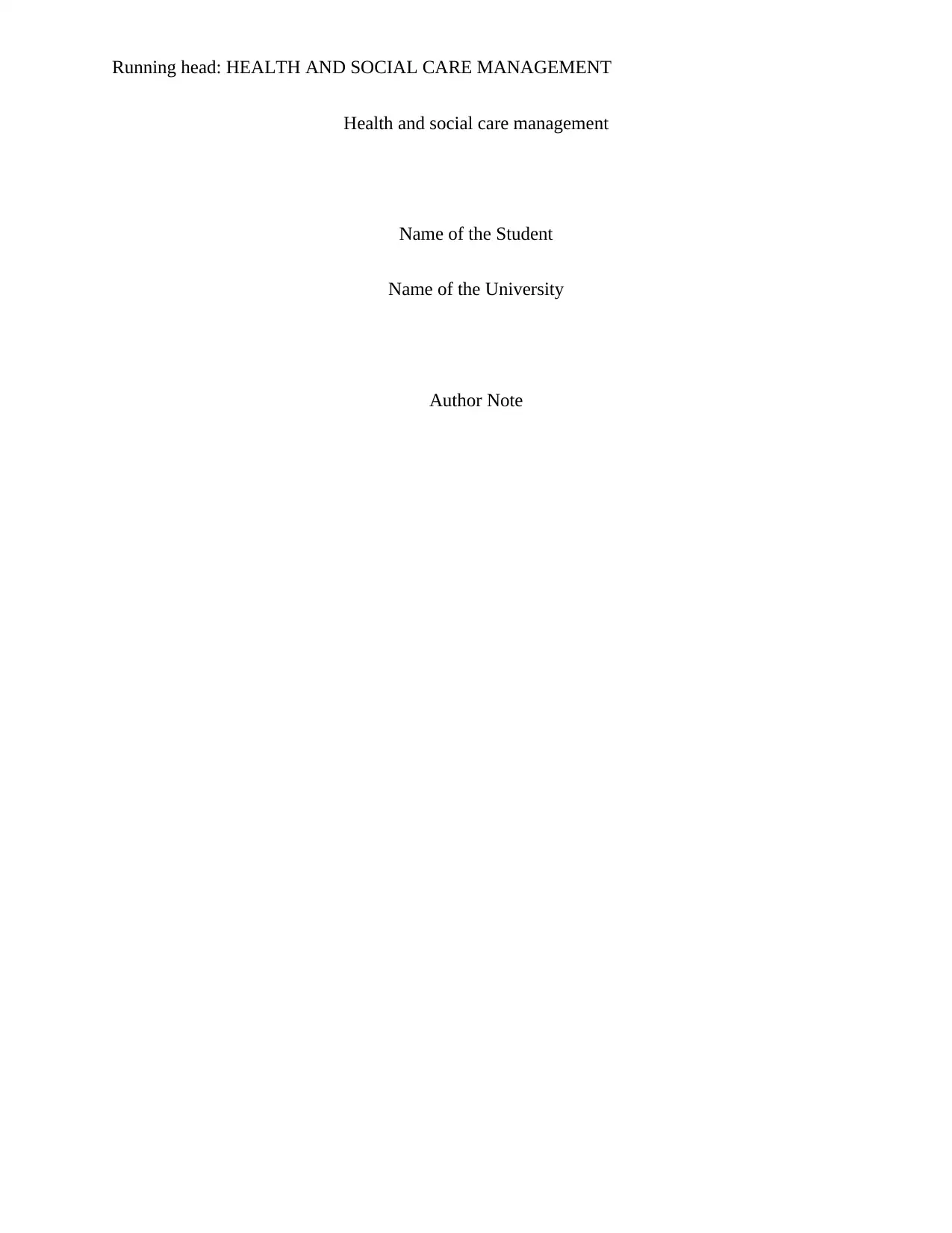
Running head: HEALTH AND SOCIAL CARE MANAGEMENT
Health and social care management
Name of the Student
Name of the University
Author Note
Health and social care management
Name of the Student
Name of the University
Author Note
Paraphrase This Document
Need a fresh take? Get an instant paraphrase of this document with our AI Paraphraser
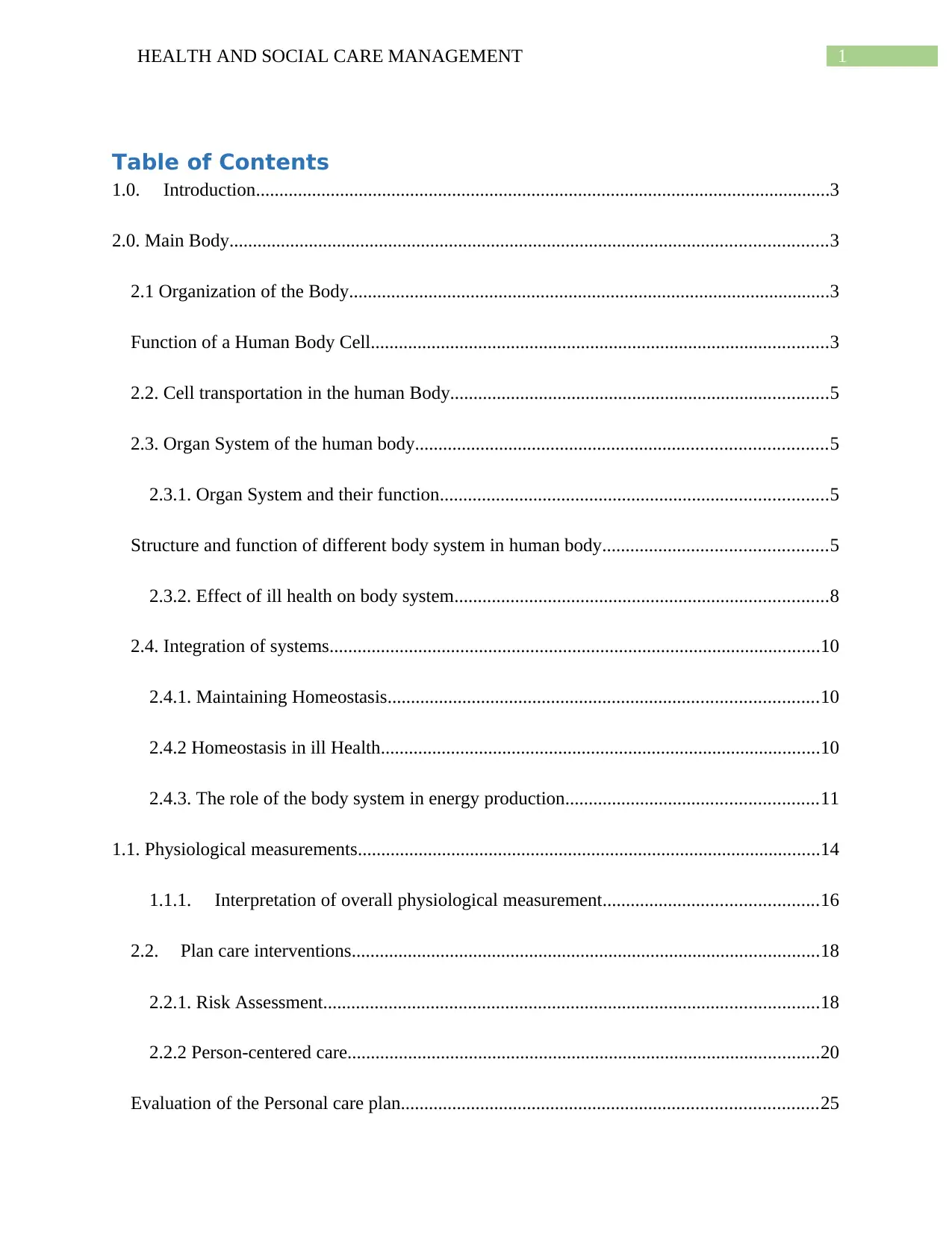
1HEALTH AND SOCIAL CARE MANAGEMENT
Table of Contents
1.0. Introduction...........................................................................................................................3
2.0. Main Body................................................................................................................................3
2.1 Organization of the Body.......................................................................................................3
Function of a Human Body Cell..................................................................................................3
2.2. Cell transportation in the human Body.................................................................................5
2.3. Organ System of the human body........................................................................................5
2.3.1. Organ System and their function...................................................................................5
Structure and function of different body system in human body................................................5
2.3.2. Effect of ill health on body system................................................................................8
2.4. Integration of systems.........................................................................................................10
2.4.1. Maintaining Homeostasis............................................................................................10
2.4.2 Homeostasis in ill Health..............................................................................................10
2.4.3. The role of the body system in energy production......................................................11
1.1. Physiological measurements...................................................................................................14
1.1.1. Interpretation of overall physiological measurement..............................................16
2.2. Plan care interventions....................................................................................................18
2.2.1. Risk Assessment..........................................................................................................18
2.2.2 Person-centered care.....................................................................................................20
Evaluation of the Personal care plan.........................................................................................25
Table of Contents
1.0. Introduction...........................................................................................................................3
2.0. Main Body................................................................................................................................3
2.1 Organization of the Body.......................................................................................................3
Function of a Human Body Cell..................................................................................................3
2.2. Cell transportation in the human Body.................................................................................5
2.3. Organ System of the human body........................................................................................5
2.3.1. Organ System and their function...................................................................................5
Structure and function of different body system in human body................................................5
2.3.2. Effect of ill health on body system................................................................................8
2.4. Integration of systems.........................................................................................................10
2.4.1. Maintaining Homeostasis............................................................................................10
2.4.2 Homeostasis in ill Health..............................................................................................10
2.4.3. The role of the body system in energy production......................................................11
1.1. Physiological measurements...................................................................................................14
1.1.1. Interpretation of overall physiological measurement..............................................16
2.2. Plan care interventions....................................................................................................18
2.2.1. Risk Assessment..........................................................................................................18
2.2.2 Person-centered care.....................................................................................................20
Evaluation of the Personal care plan.........................................................................................25
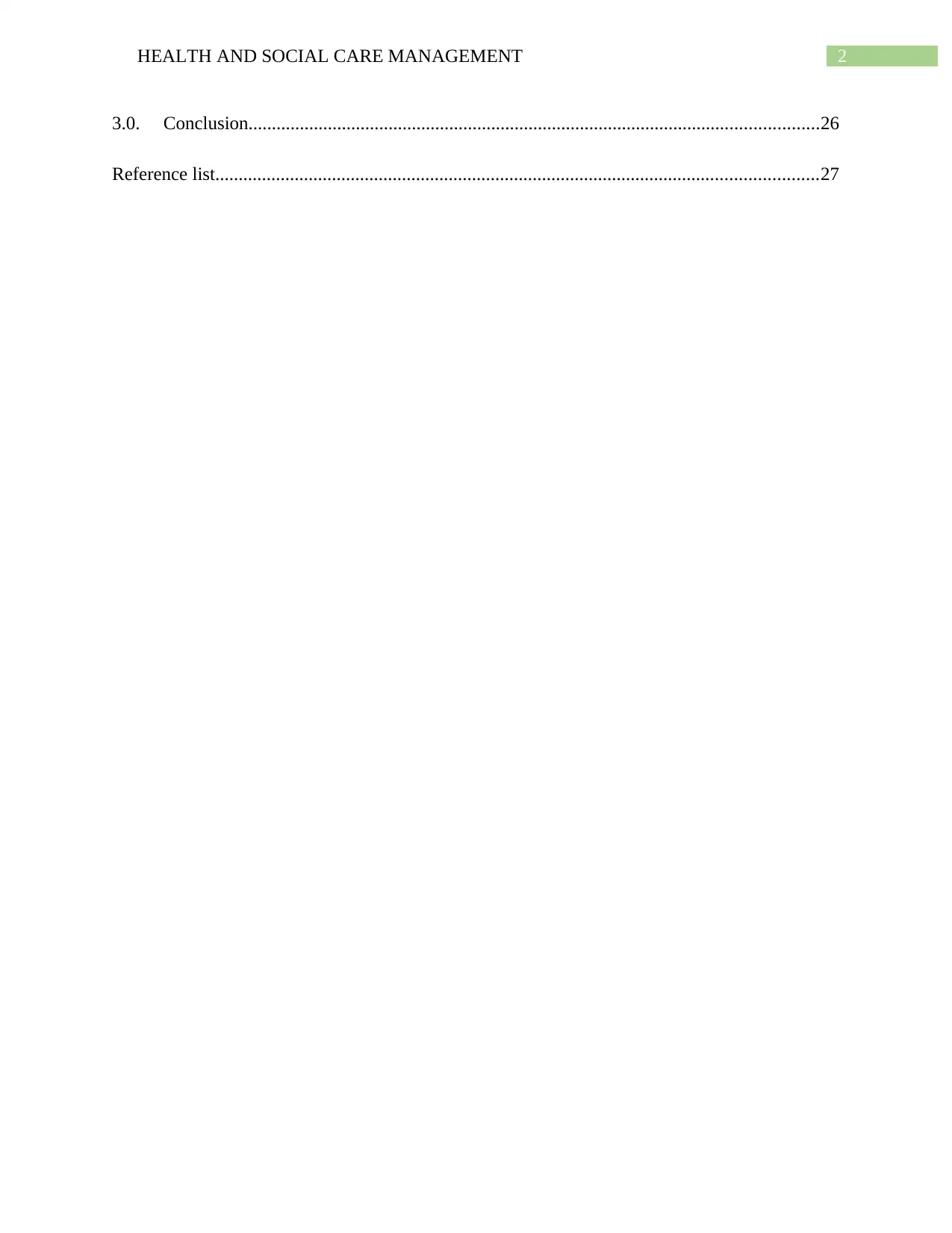
2HEALTH AND SOCIAL CARE MANAGEMENT
3.0. Conclusion..........................................................................................................................26
Reference list.................................................................................................................................27
3.0. Conclusion..........................................................................................................................26
Reference list.................................................................................................................................27
⊘ This is a preview!⊘
Do you want full access?
Subscribe today to unlock all pages.

Trusted by 1+ million students worldwide
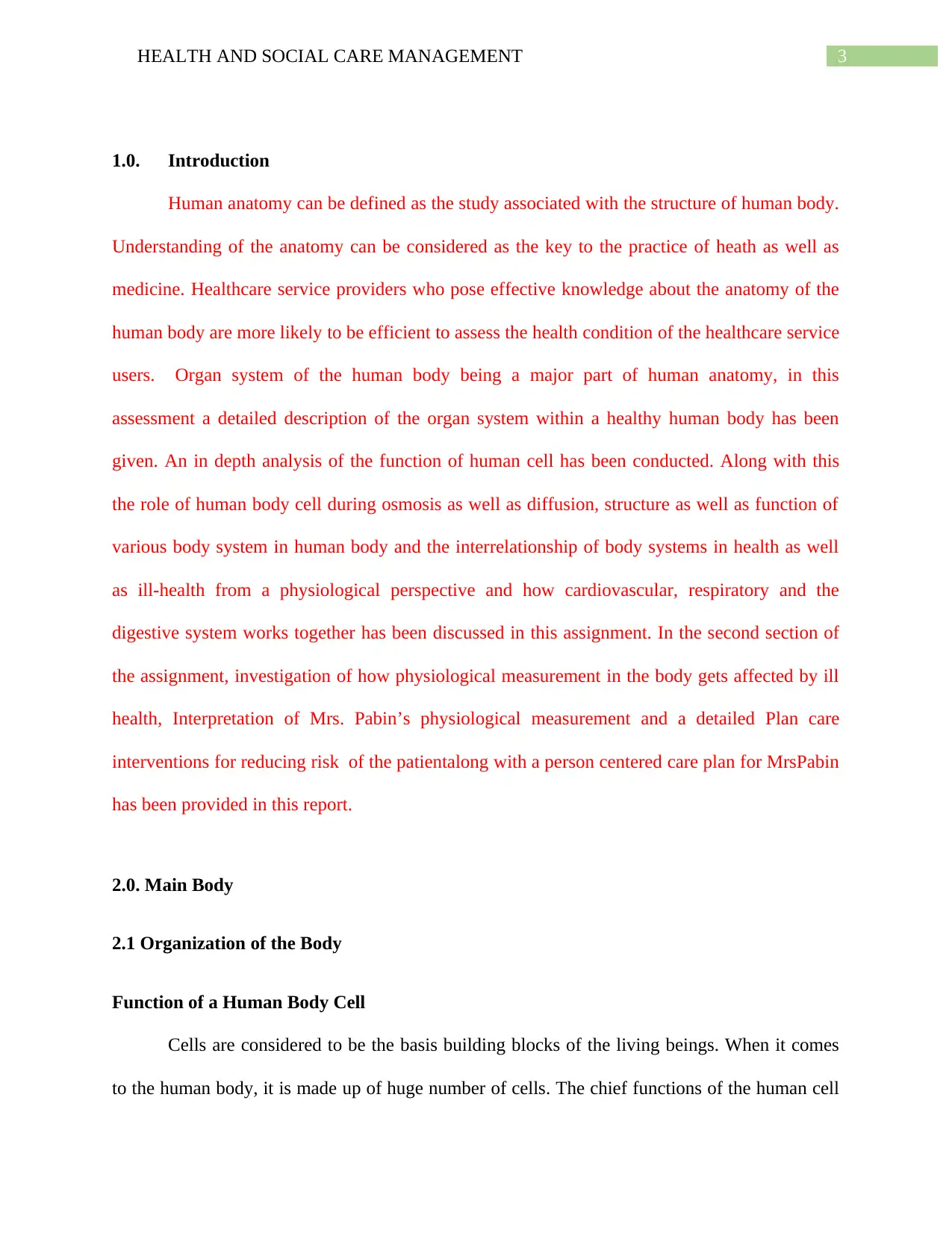
3HEALTH AND SOCIAL CARE MANAGEMENT
1.0. Introduction
Human anatomy can be defined as the study associated with the structure of human body.
Understanding of the anatomy can be considered as the key to the practice of heath as well as
medicine. Healthcare service providers who pose effective knowledge about the anatomy of the
human body are more likely to be efficient to assess the health condition of the healthcare service
users. Organ system of the human body being a major part of human anatomy, in this
assessment a detailed description of the organ system within a healthy human body has been
given. An in depth analysis of the function of human cell has been conducted. Along with this
the role of human body cell during osmosis as well as diffusion, structure as well as function of
various body system in human body and the interrelationship of body systems in health as well
as ill-health from a physiological perspective and how cardiovascular, respiratory and the
digestive system works together has been discussed in this assignment. In the second section of
the assignment, investigation of how physiological measurement in the body gets affected by ill
health, Interpretation of Mrs. Pabin’s physiological measurement and a detailed Plan care
interventions for reducing risk of the patientalong with a person centered care plan for MrsPabin
has been provided in this report.
2.0. Main Body
2.1 Organization of the Body
Function of a Human Body Cell
Cells are considered to be the basis building blocks of the living beings. When it comes
to the human body, it is made up of huge number of cells. The chief functions of the human cell
1.0. Introduction
Human anatomy can be defined as the study associated with the structure of human body.
Understanding of the anatomy can be considered as the key to the practice of heath as well as
medicine. Healthcare service providers who pose effective knowledge about the anatomy of the
human body are more likely to be efficient to assess the health condition of the healthcare service
users. Organ system of the human body being a major part of human anatomy, in this
assessment a detailed description of the organ system within a healthy human body has been
given. An in depth analysis of the function of human cell has been conducted. Along with this
the role of human body cell during osmosis as well as diffusion, structure as well as function of
various body system in human body and the interrelationship of body systems in health as well
as ill-health from a physiological perspective and how cardiovascular, respiratory and the
digestive system works together has been discussed in this assignment. In the second section of
the assignment, investigation of how physiological measurement in the body gets affected by ill
health, Interpretation of Mrs. Pabin’s physiological measurement and a detailed Plan care
interventions for reducing risk of the patientalong with a person centered care plan for MrsPabin
has been provided in this report.
2.0. Main Body
2.1 Organization of the Body
Function of a Human Body Cell
Cells are considered to be the basis building blocks of the living beings. When it comes
to the human body, it is made up of huge number of cells. The chief functions of the human cell
Paraphrase This Document
Need a fresh take? Get an instant paraphrase of this document with our AI Paraphraser
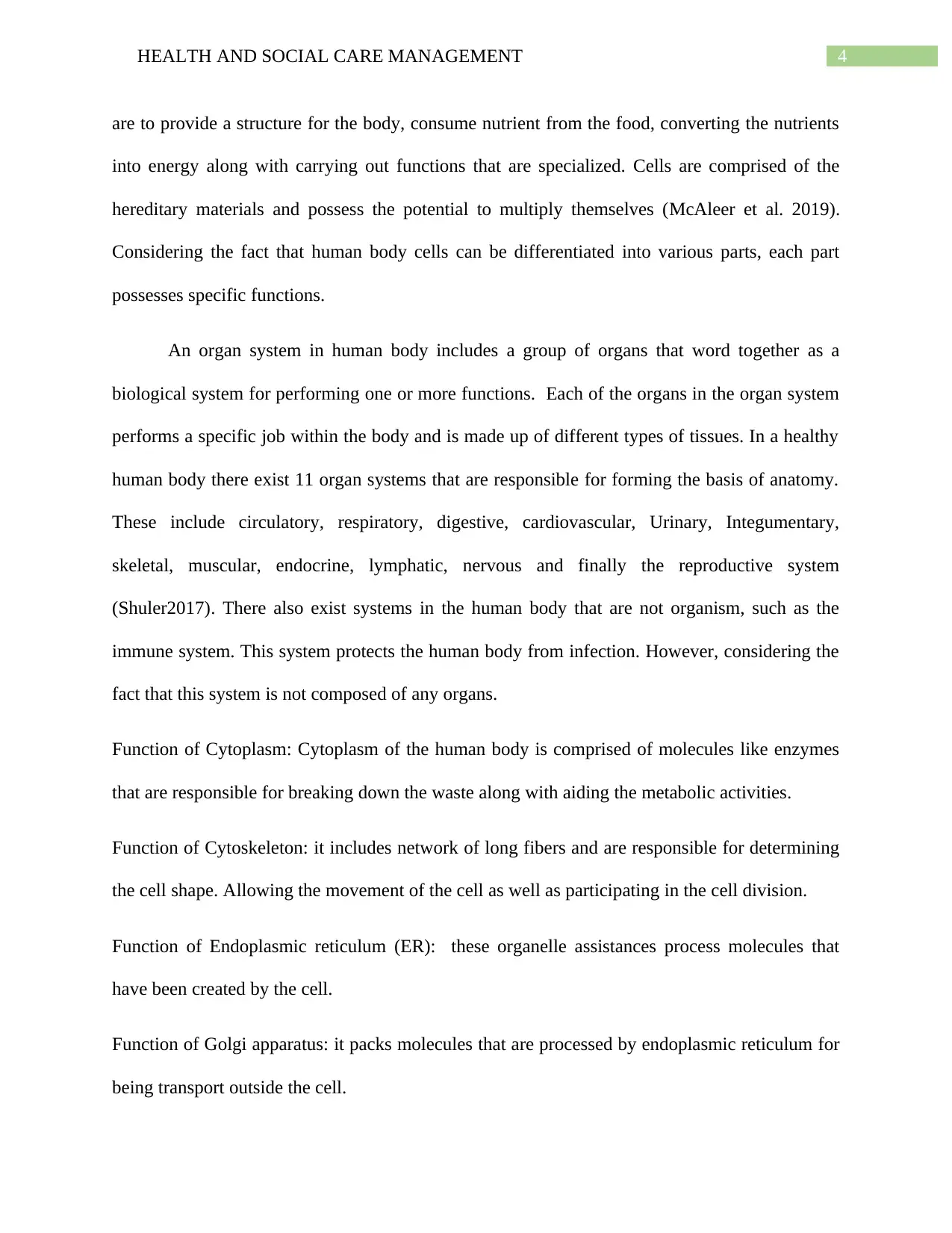
4HEALTH AND SOCIAL CARE MANAGEMENT
are to provide a structure for the body, consume nutrient from the food, converting the nutrients
into energy along with carrying out functions that are specialized. Cells are comprised of the
hereditary materials and possess the potential to multiply themselves (McAleer et al. 2019).
Considering the fact that human body cells can be differentiated into various parts, each part
possesses specific functions.
An organ system in human body includes a group of organs that word together as a
biological system for performing one or more functions. Each of the organs in the organ system
performs a specific job within the body and is made up of different types of tissues. In a healthy
human body there exist 11 organ systems that are responsible for forming the basis of anatomy.
These include circulatory, respiratory, digestive, cardiovascular, Urinary, Integumentary,
skeletal, muscular, endocrine, lymphatic, nervous and finally the reproductive system
(Shuler2017). There also exist systems in the human body that are not organism, such as the
immune system. This system protects the human body from infection. However, considering the
fact that this system is not composed of any organs.
Function of Cytoplasm: Cytoplasm of the human body is comprised of molecules like enzymes
that are responsible for breaking down the waste along with aiding the metabolic activities.
Function of Cytoskeleton: it includes network of long fibers and are responsible for determining
the cell shape. Allowing the movement of the cell as well as participating in the cell division.
Function of Endoplasmic reticulum (ER): these organelle assistances process molecules that
have been created by the cell.
Function of Golgi apparatus: it packs molecules that are processed by endoplasmic reticulum for
being transport outside the cell.
are to provide a structure for the body, consume nutrient from the food, converting the nutrients
into energy along with carrying out functions that are specialized. Cells are comprised of the
hereditary materials and possess the potential to multiply themselves (McAleer et al. 2019).
Considering the fact that human body cells can be differentiated into various parts, each part
possesses specific functions.
An organ system in human body includes a group of organs that word together as a
biological system for performing one or more functions. Each of the organs in the organ system
performs a specific job within the body and is made up of different types of tissues. In a healthy
human body there exist 11 organ systems that are responsible for forming the basis of anatomy.
These include circulatory, respiratory, digestive, cardiovascular, Urinary, Integumentary,
skeletal, muscular, endocrine, lymphatic, nervous and finally the reproductive system
(Shuler2017). There also exist systems in the human body that are not organism, such as the
immune system. This system protects the human body from infection. However, considering the
fact that this system is not composed of any organs.
Function of Cytoplasm: Cytoplasm of the human body is comprised of molecules like enzymes
that are responsible for breaking down the waste along with aiding the metabolic activities.
Function of Cytoskeleton: it includes network of long fibers and are responsible for determining
the cell shape. Allowing the movement of the cell as well as participating in the cell division.
Function of Endoplasmic reticulum (ER): these organelle assistances process molecules that
have been created by the cell.
Function of Golgi apparatus: it packs molecules that are processed by endoplasmic reticulum for
being transport outside the cell.
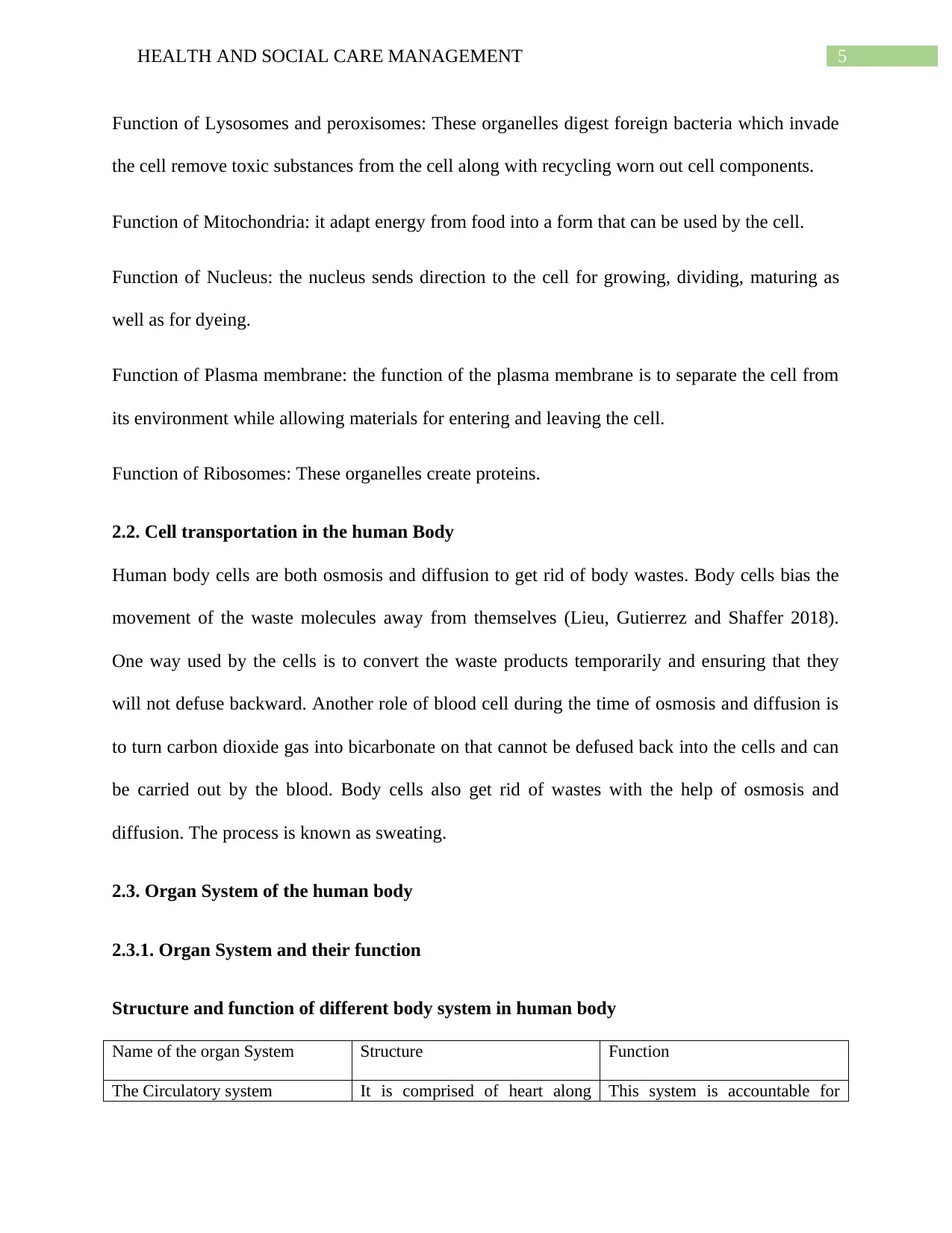
5HEALTH AND SOCIAL CARE MANAGEMENT
Function of Lysosomes and peroxisomes: These organelles digest foreign bacteria which invade
the cell remove toxic substances from the cell along with recycling worn out cell components.
Function of Mitochondria: it adapt energy from food into a form that can be used by the cell.
Function of Nucleus: the nucleus sends direction to the cell for growing, dividing, maturing as
well as for dyeing.
Function of Plasma membrane: the function of the plasma membrane is to separate the cell from
its environment while allowing materials for entering and leaving the cell.
Function of Ribosomes: These organelles create proteins.
2.2. Cell transportation in the human Body
Human body cells are both osmosis and diffusion to get rid of body wastes. Body cells bias the
movement of the waste molecules away from themselves (Lieu, Gutierrez and Shaffer 2018).
One way used by the cells is to convert the waste products temporarily and ensuring that they
will not defuse backward. Another role of blood cell during the time of osmosis and diffusion is
to turn carbon dioxide gas into bicarbonate on that cannot be defused back into the cells and can
be carried out by the blood. Body cells also get rid of wastes with the help of osmosis and
diffusion. The process is known as sweating.
2.3. Organ System of the human body
2.3.1. Organ System and their function
Structure and function of different body system in human body
Name of the organ System Structure Function
The Circulatory system It is comprised of heart along This system is accountable for
Function of Lysosomes and peroxisomes: These organelles digest foreign bacteria which invade
the cell remove toxic substances from the cell along with recycling worn out cell components.
Function of Mitochondria: it adapt energy from food into a form that can be used by the cell.
Function of Nucleus: the nucleus sends direction to the cell for growing, dividing, maturing as
well as for dyeing.
Function of Plasma membrane: the function of the plasma membrane is to separate the cell from
its environment while allowing materials for entering and leaving the cell.
Function of Ribosomes: These organelles create proteins.
2.2. Cell transportation in the human Body
Human body cells are both osmosis and diffusion to get rid of body wastes. Body cells bias the
movement of the waste molecules away from themselves (Lieu, Gutierrez and Shaffer 2018).
One way used by the cells is to convert the waste products temporarily and ensuring that they
will not defuse backward. Another role of blood cell during the time of osmosis and diffusion is
to turn carbon dioxide gas into bicarbonate on that cannot be defused back into the cells and can
be carried out by the blood. Body cells also get rid of wastes with the help of osmosis and
diffusion. The process is known as sweating.
2.3. Organ System of the human body
2.3.1. Organ System and their function
Structure and function of different body system in human body
Name of the organ System Structure Function
The Circulatory system It is comprised of heart along This system is accountable for
⊘ This is a preview!⊘
Do you want full access?
Subscribe today to unlock all pages.

Trusted by 1+ million students worldwide
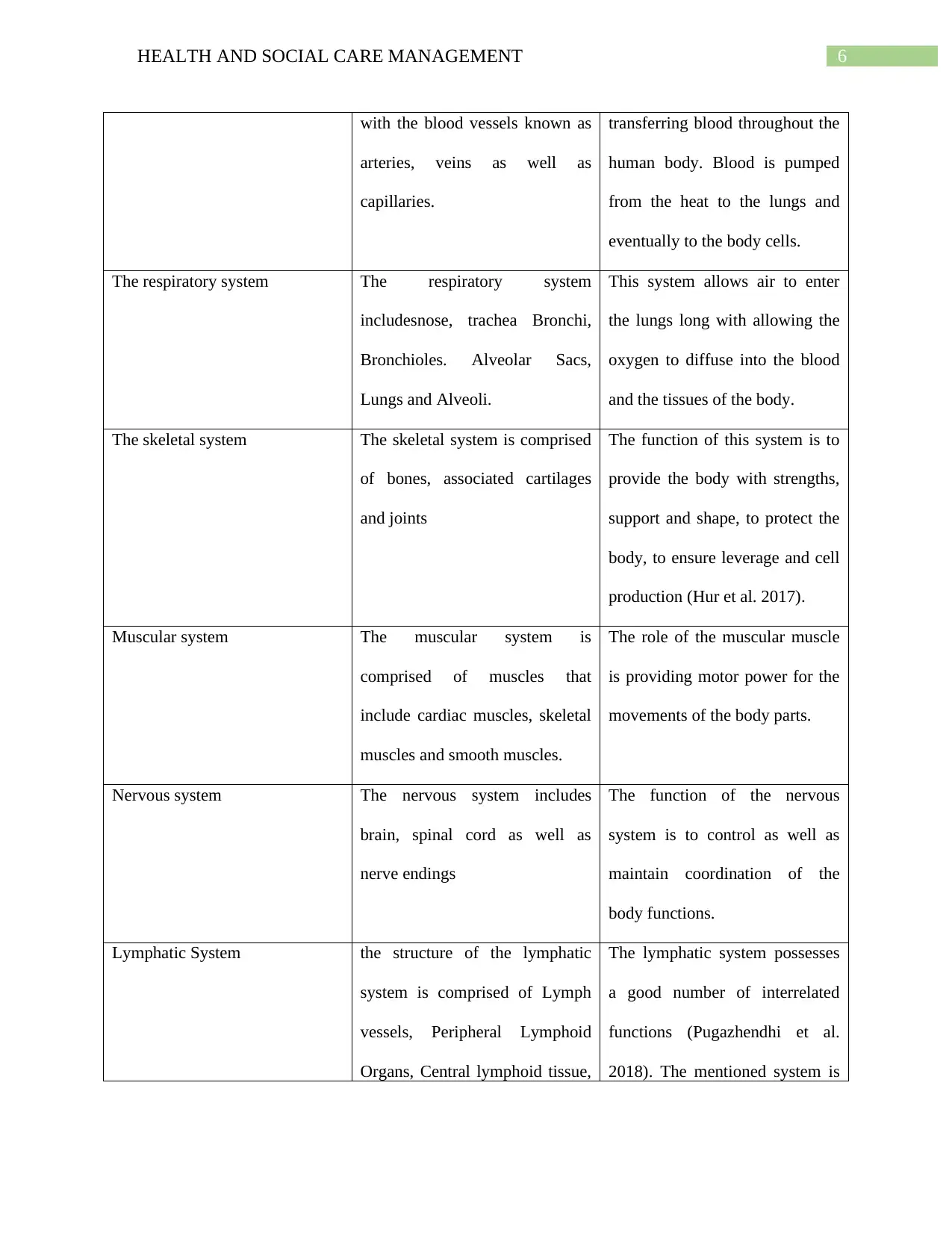
6HEALTH AND SOCIAL CARE MANAGEMENT
with the blood vessels known as
arteries, veins as well as
capillaries.
transferring blood throughout the
human body. Blood is pumped
from the heat to the lungs and
eventually to the body cells.
The respiratory system The respiratory system
includesnose, trachea Bronchi,
Bronchioles. Alveolar Sacs,
Lungs and Alveoli.
This system allows air to enter
the lungs long with allowing the
oxygen to diffuse into the blood
and the tissues of the body.
The skeletal system The skeletal system is comprised
of bones, associated cartilages
and joints
The function of this system is to
provide the body with strengths,
support and shape, to protect the
body, to ensure leverage and cell
production (Hur et al. 2017).
Muscular system The muscular system is
comprised of muscles that
include cardiac muscles, skeletal
muscles and smooth muscles.
The role of the muscular muscle
is providing motor power for the
movements of the body parts.
Nervous system The nervous system includes
brain, spinal cord as well as
nerve endings
The function of the nervous
system is to control as well as
maintain coordination of the
body functions.
Lymphatic System the structure of the lymphatic
system is comprised of Lymph
vessels, Peripheral Lymphoid
Organs, Central lymphoid tissue,
The lymphatic system possesses
a good number of interrelated
functions (Pugazhendhi et al.
2018). The mentioned system is
with the blood vessels known as
arteries, veins as well as
capillaries.
transferring blood throughout the
human body. Blood is pumped
from the heat to the lungs and
eventually to the body cells.
The respiratory system The respiratory system
includesnose, trachea Bronchi,
Bronchioles. Alveolar Sacs,
Lungs and Alveoli.
This system allows air to enter
the lungs long with allowing the
oxygen to diffuse into the blood
and the tissues of the body.
The skeletal system The skeletal system is comprised
of bones, associated cartilages
and joints
The function of this system is to
provide the body with strengths,
support and shape, to protect the
body, to ensure leverage and cell
production (Hur et al. 2017).
Muscular system The muscular system is
comprised of muscles that
include cardiac muscles, skeletal
muscles and smooth muscles.
The role of the muscular muscle
is providing motor power for the
movements of the body parts.
Nervous system The nervous system includes
brain, spinal cord as well as
nerve endings
The function of the nervous
system is to control as well as
maintain coordination of the
body functions.
Lymphatic System the structure of the lymphatic
system is comprised of Lymph
vessels, Peripheral Lymphoid
Organs, Central lymphoid tissue,
The lymphatic system possesses
a good number of interrelated
functions (Pugazhendhi et al.
2018). The mentioned system is
Paraphrase This Document
Need a fresh take? Get an instant paraphrase of this document with our AI Paraphraser
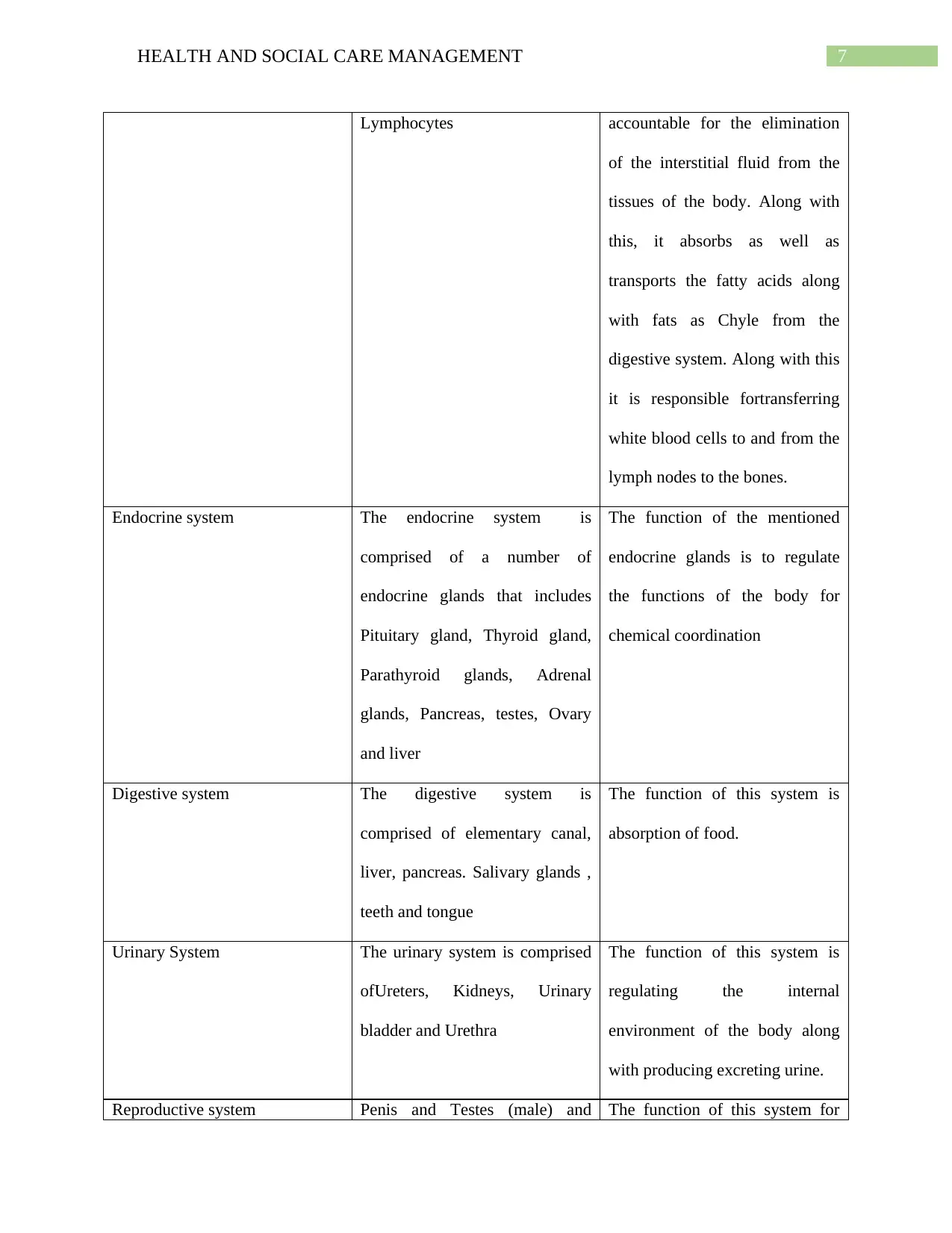
7HEALTH AND SOCIAL CARE MANAGEMENT
Lymphocytes accountable for the elimination
of the interstitial fluid from the
tissues of the body. Along with
this, it absorbs as well as
transports the fatty acids along
with fats as Chyle from the
digestive system. Along with this
it is responsible fortransferring
white blood cells to and from the
lymph nodes to the bones.
Endocrine system The endocrine system is
comprised of a number of
endocrine glands that includes
Pituitary gland, Thyroid gland,
Parathyroid glands, Adrenal
glands, Pancreas, testes, Ovary
and liver
The function of the mentioned
endocrine glands is to regulate
the functions of the body for
chemical coordination
Digestive system The digestive system is
comprised of elementary canal,
liver, pancreas. Salivary glands ,
teeth and tongue
The function of this system is
absorption of food.
Urinary System The urinary system is comprised
ofUreters, Kidneys, Urinary
bladder and Urethra
The function of this system is
regulating the internal
environment of the body along
with producing excreting urine.
Reproductive system Penis and Testes (male) and The function of this system for
Lymphocytes accountable for the elimination
of the interstitial fluid from the
tissues of the body. Along with
this, it absorbs as well as
transports the fatty acids along
with fats as Chyle from the
digestive system. Along with this
it is responsible fortransferring
white blood cells to and from the
lymph nodes to the bones.
Endocrine system The endocrine system is
comprised of a number of
endocrine glands that includes
Pituitary gland, Thyroid gland,
Parathyroid glands, Adrenal
glands, Pancreas, testes, Ovary
and liver
The function of the mentioned
endocrine glands is to regulate
the functions of the body for
chemical coordination
Digestive system The digestive system is
comprised of elementary canal,
liver, pancreas. Salivary glands ,
teeth and tongue
The function of this system is
absorption of food.
Urinary System The urinary system is comprised
ofUreters, Kidneys, Urinary
bladder and Urethra
The function of this system is
regulating the internal
environment of the body along
with producing excreting urine.
Reproductive system Penis and Testes (male) and The function of this system for
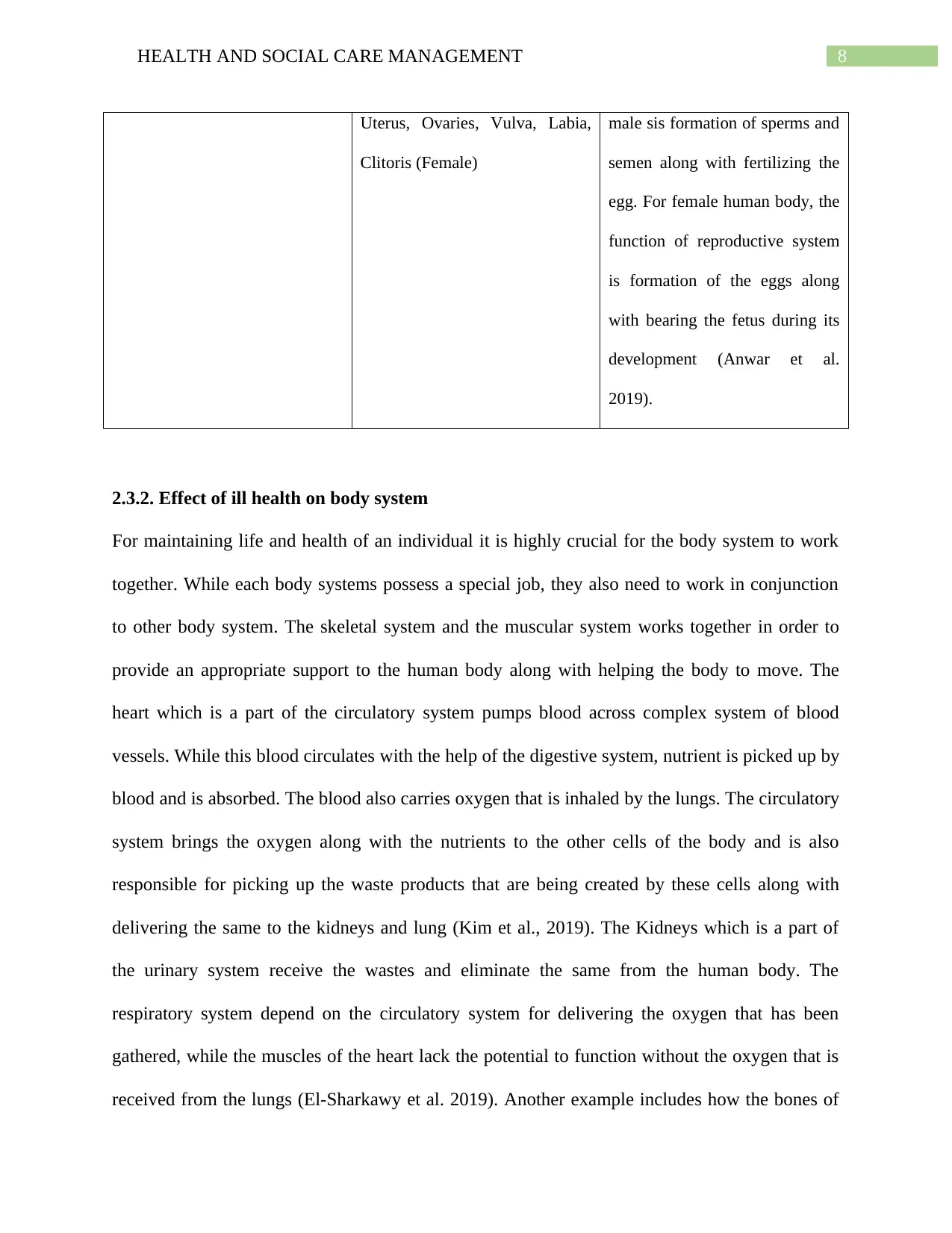
8HEALTH AND SOCIAL CARE MANAGEMENT
Uterus, Ovaries, Vulva, Labia,
Clitoris (Female)
male sis formation of sperms and
semen along with fertilizing the
egg. For female human body, the
function of reproductive system
is formation of the eggs along
with bearing the fetus during its
development (Anwar et al.
2019).
2.3.2. Effect of ill health on body system
For maintaining life and health of an individual it is highly crucial for the body system to work
together. While each body systems possess a special job, they also need to work in conjunction
to other body system. The skeletal system and the muscular system works together in order to
provide an appropriate support to the human body along with helping the body to move. The
heart which is a part of the circulatory system pumps blood across complex system of blood
vessels. While this blood circulates with the help of the digestive system, nutrient is picked up by
blood and is absorbed. The blood also carries oxygen that is inhaled by the lungs. The circulatory
system brings the oxygen along with the nutrients to the other cells of the body and is also
responsible for picking up the waste products that are being created by these cells along with
delivering the same to the kidneys and lung (Kim et al., 2019). The Kidneys which is a part of
the urinary system receive the wastes and eliminate the same from the human body. The
respiratory system depend on the circulatory system for delivering the oxygen that has been
gathered, while the muscles of the heart lack the potential to function without the oxygen that is
received from the lungs (El-Sharkawy et al. 2019). Another example includes how the bones of
Uterus, Ovaries, Vulva, Labia,
Clitoris (Female)
male sis formation of sperms and
semen along with fertilizing the
egg. For female human body, the
function of reproductive system
is formation of the eggs along
with bearing the fetus during its
development (Anwar et al.
2019).
2.3.2. Effect of ill health on body system
For maintaining life and health of an individual it is highly crucial for the body system to work
together. While each body systems possess a special job, they also need to work in conjunction
to other body system. The skeletal system and the muscular system works together in order to
provide an appropriate support to the human body along with helping the body to move. The
heart which is a part of the circulatory system pumps blood across complex system of blood
vessels. While this blood circulates with the help of the digestive system, nutrient is picked up by
blood and is absorbed. The blood also carries oxygen that is inhaled by the lungs. The circulatory
system brings the oxygen along with the nutrients to the other cells of the body and is also
responsible for picking up the waste products that are being created by these cells along with
delivering the same to the kidneys and lung (Kim et al., 2019). The Kidneys which is a part of
the urinary system receive the wastes and eliminate the same from the human body. The
respiratory system depend on the circulatory system for delivering the oxygen that has been
gathered, while the muscles of the heart lack the potential to function without the oxygen that is
received from the lungs (El-Sharkawy et al. 2019). Another example includes how the bones of
⊘ This is a preview!⊘
Do you want full access?
Subscribe today to unlock all pages.

Trusted by 1+ million students worldwide
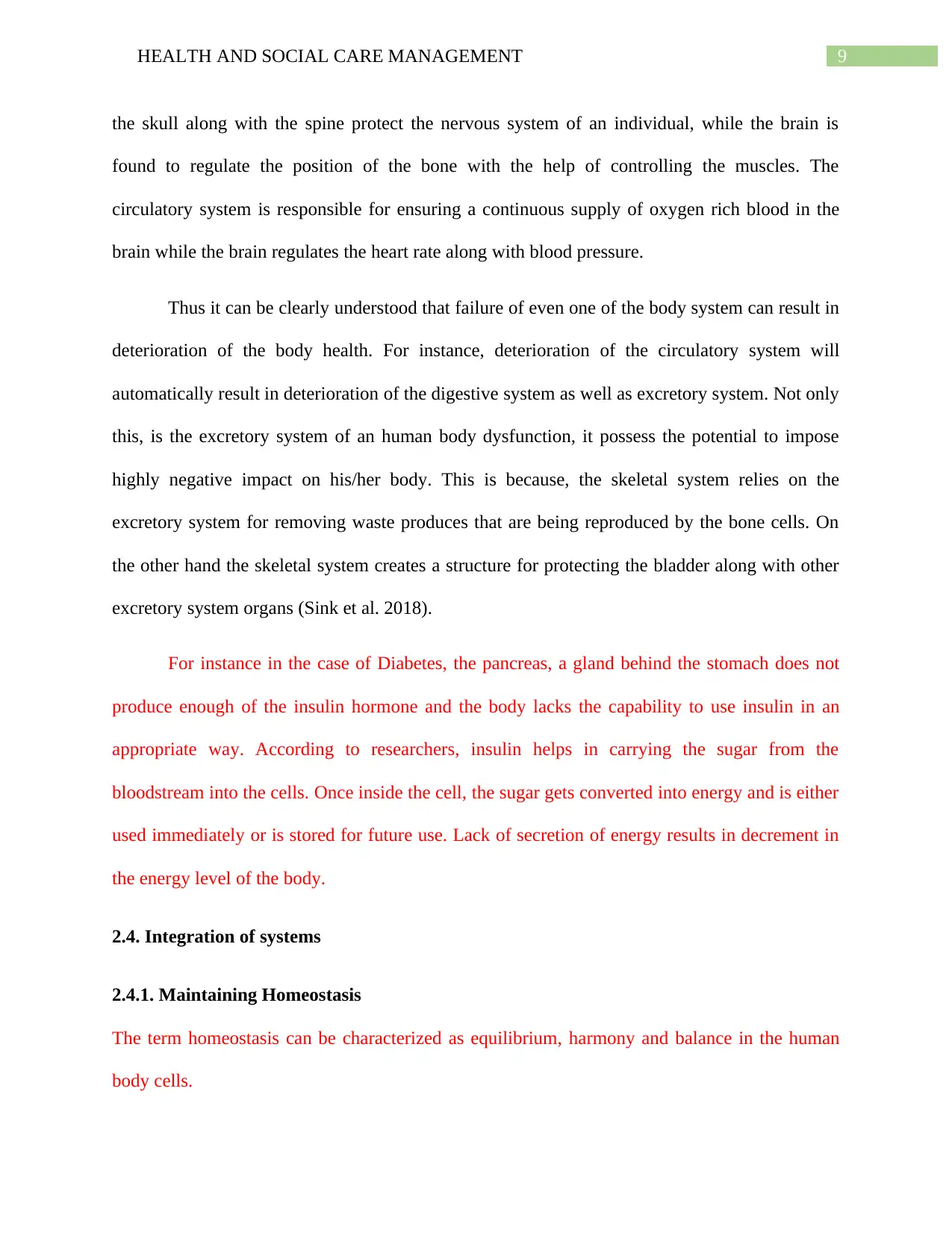
9HEALTH AND SOCIAL CARE MANAGEMENT
the skull along with the spine protect the nervous system of an individual, while the brain is
found to regulate the position of the bone with the help of controlling the muscles. The
circulatory system is responsible for ensuring a continuous supply of oxygen rich blood in the
brain while the brain regulates the heart rate along with blood pressure.
Thus it can be clearly understood that failure of even one of the body system can result in
deterioration of the body health. For instance, deterioration of the circulatory system will
automatically result in deterioration of the digestive system as well as excretory system. Not only
this, is the excretory system of an human body dysfunction, it possess the potential to impose
highly negative impact on his/her body. This is because, the skeletal system relies on the
excretory system for removing waste produces that are being reproduced by the bone cells. On
the other hand the skeletal system creates a structure for protecting the bladder along with other
excretory system organs (Sink et al. 2018).
For instance in the case of Diabetes, the pancreas, a gland behind the stomach does not
produce enough of the insulin hormone and the body lacks the capability to use insulin in an
appropriate way. According to researchers, insulin helps in carrying the sugar from the
bloodstream into the cells. Once inside the cell, the sugar gets converted into energy and is either
used immediately or is stored for future use. Lack of secretion of energy results in decrement in
the energy level of the body.
2.4. Integration of systems
2.4.1. Maintaining Homeostasis
The term homeostasis can be characterized as equilibrium, harmony and balance in the human
body cells.
the skull along with the spine protect the nervous system of an individual, while the brain is
found to regulate the position of the bone with the help of controlling the muscles. The
circulatory system is responsible for ensuring a continuous supply of oxygen rich blood in the
brain while the brain regulates the heart rate along with blood pressure.
Thus it can be clearly understood that failure of even one of the body system can result in
deterioration of the body health. For instance, deterioration of the circulatory system will
automatically result in deterioration of the digestive system as well as excretory system. Not only
this, is the excretory system of an human body dysfunction, it possess the potential to impose
highly negative impact on his/her body. This is because, the skeletal system relies on the
excretory system for removing waste produces that are being reproduced by the bone cells. On
the other hand the skeletal system creates a structure for protecting the bladder along with other
excretory system organs (Sink et al. 2018).
For instance in the case of Diabetes, the pancreas, a gland behind the stomach does not
produce enough of the insulin hormone and the body lacks the capability to use insulin in an
appropriate way. According to researchers, insulin helps in carrying the sugar from the
bloodstream into the cells. Once inside the cell, the sugar gets converted into energy and is either
used immediately or is stored for future use. Lack of secretion of energy results in decrement in
the energy level of the body.
2.4. Integration of systems
2.4.1. Maintaining Homeostasis
The term homeostasis can be characterized as equilibrium, harmony and balance in the human
body cells.
Paraphrase This Document
Need a fresh take? Get an instant paraphrase of this document with our AI Paraphraser
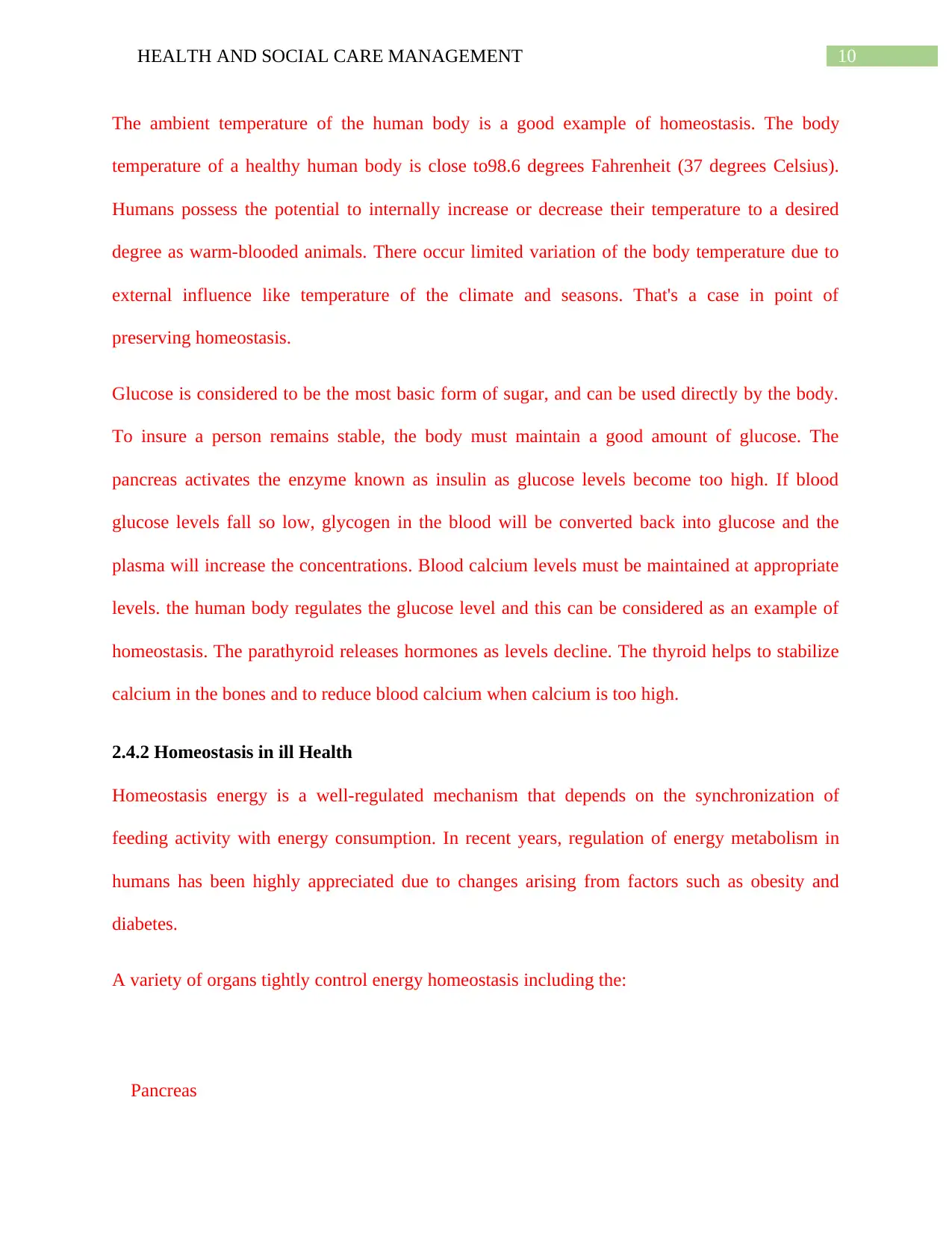
10HEALTH AND SOCIAL CARE MANAGEMENT
The ambient temperature of the human body is a good example of homeostasis. The body
temperature of a healthy human body is close to98.6 degrees Fahrenheit (37 degrees Celsius).
Humans possess the potential to internally increase or decrease their temperature to a desired
degree as warm-blooded animals. There occur limited variation of the body temperature due to
external influence like temperature of the climate and seasons. That's a case in point of
preserving homeostasis.
Glucose is considered to be the most basic form of sugar, and can be used directly by the body.
To insure a person remains stable, the body must maintain a good amount of glucose. The
pancreas activates the enzyme known as insulin as glucose levels become too high. If blood
glucose levels fall so low, glycogen in the blood will be converted back into glucose and the
plasma will increase the concentrations. Blood calcium levels must be maintained at appropriate
levels. the human body regulates the glucose level and this can be considered as an example of
homeostasis. The parathyroid releases hormones as levels decline. The thyroid helps to stabilize
calcium in the bones and to reduce blood calcium when calcium is too high.
2.4.2 Homeostasis in ill Health
Homeostasis energy is a well-regulated mechanism that depends on the synchronization of
feeding activity with energy consumption. In recent years, regulation of energy metabolism in
humans has been highly appreciated due to changes arising from factors such as obesity and
diabetes.
A variety of organs tightly control energy homeostasis including the:
Pancreas
The ambient temperature of the human body is a good example of homeostasis. The body
temperature of a healthy human body is close to98.6 degrees Fahrenheit (37 degrees Celsius).
Humans possess the potential to internally increase or decrease their temperature to a desired
degree as warm-blooded animals. There occur limited variation of the body temperature due to
external influence like temperature of the climate and seasons. That's a case in point of
preserving homeostasis.
Glucose is considered to be the most basic form of sugar, and can be used directly by the body.
To insure a person remains stable, the body must maintain a good amount of glucose. The
pancreas activates the enzyme known as insulin as glucose levels become too high. If blood
glucose levels fall so low, glycogen in the blood will be converted back into glucose and the
plasma will increase the concentrations. Blood calcium levels must be maintained at appropriate
levels. the human body regulates the glucose level and this can be considered as an example of
homeostasis. The parathyroid releases hormones as levels decline. The thyroid helps to stabilize
calcium in the bones and to reduce blood calcium when calcium is too high.
2.4.2 Homeostasis in ill Health
Homeostasis energy is a well-regulated mechanism that depends on the synchronization of
feeding activity with energy consumption. In recent years, regulation of energy metabolism in
humans has been highly appreciated due to changes arising from factors such as obesity and
diabetes.
A variety of organs tightly control energy homeostasis including the:
Pancreas
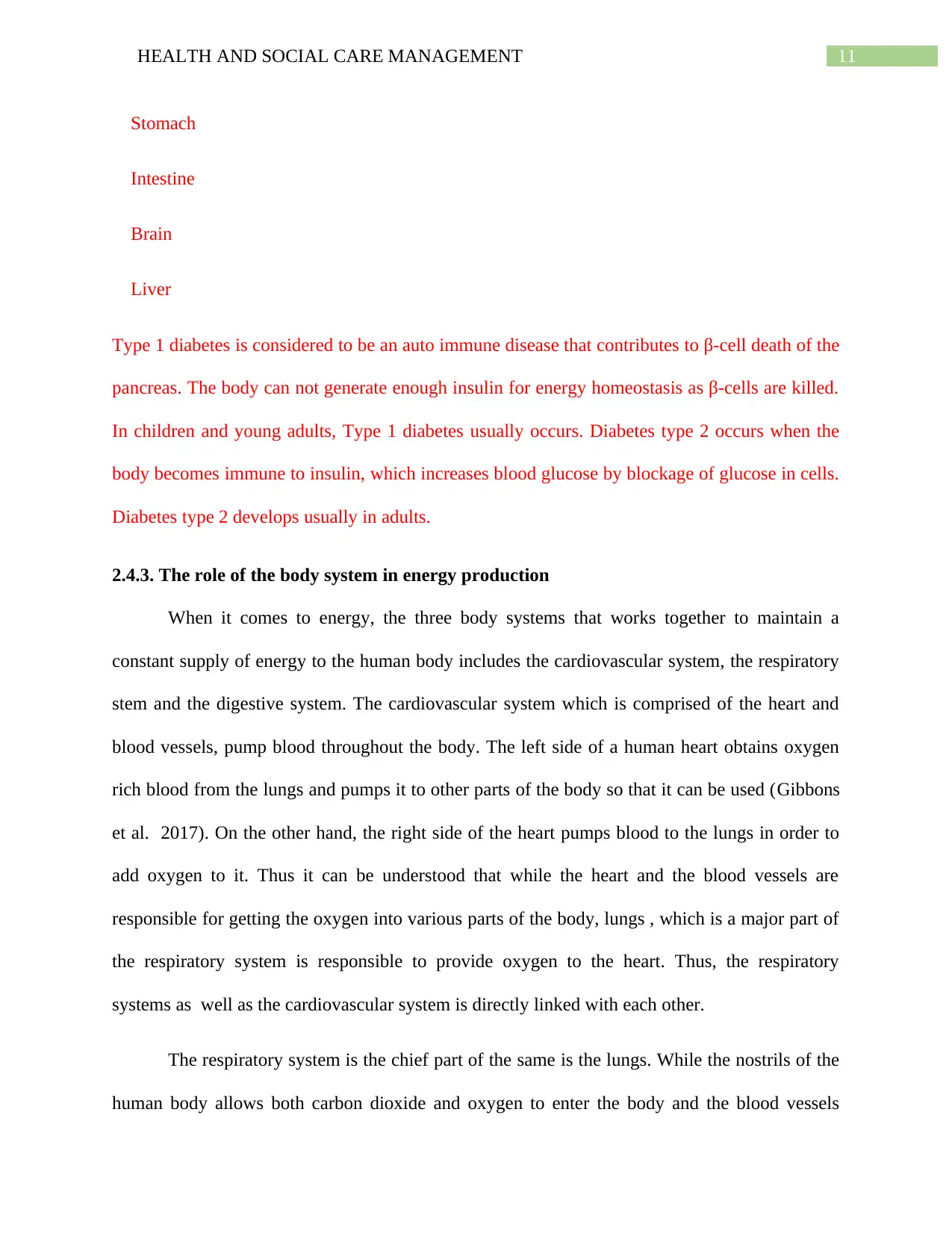
11HEALTH AND SOCIAL CARE MANAGEMENT
Stomach
Intestine
Brain
Liver
Type 1 diabetes is considered to be an auto immune disease that contributes to β-cell death of the
pancreas. The body can not generate enough insulin for energy homeostasis as β-cells are killed.
In children and young adults, Type 1 diabetes usually occurs. Diabetes type 2 occurs when the
body becomes immune to insulin, which increases blood glucose by blockage of glucose in cells.
Diabetes type 2 develops usually in adults.
2.4.3. The role of the body system in energy production
When it comes to energy, the three body systems that works together to maintain a
constant supply of energy to the human body includes the cardiovascular system, the respiratory
stem and the digestive system. The cardiovascular system which is comprised of the heart and
blood vessels, pump blood throughout the body. The left side of a human heart obtains oxygen
rich blood from the lungs and pumps it to other parts of the body so that it can be used (Gibbons
et al. 2017). On the other hand, the right side of the heart pumps blood to the lungs in order to
add oxygen to it. Thus it can be understood that while the heart and the blood vessels are
responsible for getting the oxygen into various parts of the body, lungs , which is a major part of
the respiratory system is responsible to provide oxygen to the heart. Thus, the respiratory
systems as well as the cardiovascular system is directly linked with each other.
The respiratory system is the chief part of the same is the lungs. While the nostrils of the
human body allows both carbon dioxide and oxygen to enter the body and the blood vessels
Stomach
Intestine
Brain
Liver
Type 1 diabetes is considered to be an auto immune disease that contributes to β-cell death of the
pancreas. The body can not generate enough insulin for energy homeostasis as β-cells are killed.
In children and young adults, Type 1 diabetes usually occurs. Diabetes type 2 occurs when the
body becomes immune to insulin, which increases blood glucose by blockage of glucose in cells.
Diabetes type 2 develops usually in adults.
2.4.3. The role of the body system in energy production
When it comes to energy, the three body systems that works together to maintain a
constant supply of energy to the human body includes the cardiovascular system, the respiratory
stem and the digestive system. The cardiovascular system which is comprised of the heart and
blood vessels, pump blood throughout the body. The left side of a human heart obtains oxygen
rich blood from the lungs and pumps it to other parts of the body so that it can be used (Gibbons
et al. 2017). On the other hand, the right side of the heart pumps blood to the lungs in order to
add oxygen to it. Thus it can be understood that while the heart and the blood vessels are
responsible for getting the oxygen into various parts of the body, lungs , which is a major part of
the respiratory system is responsible to provide oxygen to the heart. Thus, the respiratory
systems as well as the cardiovascular system is directly linked with each other.
The respiratory system is the chief part of the same is the lungs. While the nostrils of the
human body allows both carbon dioxide and oxygen to enter the body and the blood vessels
⊘ This is a preview!⊘
Do you want full access?
Subscribe today to unlock all pages.

Trusted by 1+ million students worldwide
1 out of 30
Related Documents
Your All-in-One AI-Powered Toolkit for Academic Success.
+13062052269
info@desklib.com
Available 24*7 on WhatsApp / Email
![[object Object]](/_next/static/media/star-bottom.7253800d.svg)
Unlock your academic potential
Copyright © 2020–2025 A2Z Services. All Rights Reserved. Developed and managed by ZUCOL.





